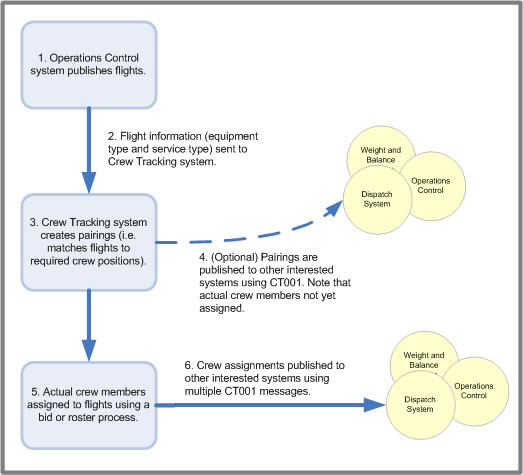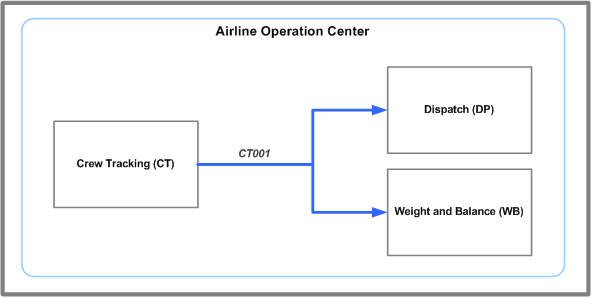
Crew Tracking
System and Message Overviews
Document Version: 5.8
Date: October 2, 2019
Document Revision History
The following revision history table reflects all substantive changes to this document.
| Date | Description of Updates Made |
04-August-08 |
Updated the message summary table. |
| 01-October-09 | Updates to CT001. |
| 18-November-09 | Updates to CT001. |
| 31-March-10 | Updates to CT001. |
14-July-10 |
In CT001, corrected error in polarQualified. |
30-August-10 |
Updated links for new Bookshelf directory structure. |
15-September-10 |
Updated Table CT001 |
| 18-November-10 | New XSD. New sample messages CT001v5. |
| 12-September-11 | New XSD. |
| 15-November-11 | New XSD. Updated CT001 |
| 23-July-13 | New XSD. |
| 3-March-14 | New XSD. |
| 26-May-15 | New XSD. Common.xsd added flightKey which had a trickle-down effect causing this xsd to be updated. |
| 2-October-19 | New XSD. Updated CT001 to version 6, Added character restriction to firstName, middleName, lastName, nickname. |
Table Of Contents
1 Introduction
This document defines the interfaces which govern the interchange of data between a Crew Tracking system and other systems within an Airline Operation Center (AOC). Each AOC interface is represented by a message described in an associated XSD (XML Schema Definition). The XSD defines and enforces the required, optional, and conditional data that can be included in a message.
Crew Tracking systems manage the daily crew scheduling operations within an airline.
1.1 Audience
The intended audience for this document includes existing and potential Jeppesen customers, integration partners, and personnel with roles associated with application architecture, application development, system testing, implementation, and application support within Crew Tracking.
1.2 Scope
This document discusses the Crew Tracking messages currently supported by the Jeppesen Solution Integrator. Each message description includes the following:
- Overview for common message uses within an AOC
- Message Version Summary listing all available versions of each message
- Links to the message specifications including direct links to XSD documentation, where you can explore the XSD hierarchy and interface specifications in a navigable HTML format
- Links to the XSD source code
- Links to sample XML messages for each AOC message
Other data iluded in this document will be considered custom and not supported.
1.3 XML Schema/Xnterfaces or formats not incSD
The XML schema for this ICD is published in the following file: CrewTracking.XSD
2 Message Summary
Table 2-1 lists the messages that can be sent or handled by the application.
Table 2-1 Message Summary
ID |
Message |
Publish |
Subscribe |
Request |
Response |
CT001 |
Crew Assignment |
X |
|
|
|
3 AOC Interface Messages
The following messages are processed by the Crew Tracking system.
3.1 CT001 - Crew Assignment
3.1.1 Message Overview
This message is used to publish crew assignments to other AOC applications from the Crew Tracking system. The Crew Assignment message is sent for initial crew assignments as well as for updates. All crew positions for a flight leg must be included in this message, but individual crew member assignments are not required.
3.1.1.1 Publishing initial crew assignments
Airlines typically undergo a crew-assignment process for all of their scheduled flights at the beginning of each month. All planned flights are sent through the Crew Tracking system, where flights are “paired” with the crew positions required for those flights. For example, an MD80 aircraft requires a crew consisting of a captain, first officer, and four flight attendants. The crew positions are identified first; the actual crew members will be assigned later in the process.
Following the initial flight-to-crew pairing, airlines undergo either a seniority-based bidding process or a rostering process to assign actual crew members to the paired positions. After actual crew members are assigned to flight legs, all assignments are published using a series of CT001 messages. One Crew Assignment message is sent for every flight leg; each message must include all of the positions required for that flight.
Figure 1 shows an example of when the CT001 message is used to assign crews to flights.

Figure 1 . Sample Crew Assignment Process
3.1.1.2 Publishing crew assignment updates
The Crew Assignment message can also be used to update and communicate crew updates resulting from a disruption to the schedule. For example, the captain of Jeppesen Airline’s flight 100 gets the flu and is unable to fly his pairing (i.e. trip), which consisted of three flight legs. The Crew Tracking system removes the sick captain from the pairing, assigns a reserve pilot to the trip, and then publishes the crew update using multiple CT001 messages—one for each flight leg. Note that all of the positions must be resent in the message, not just the update.
Crew disruptions can be caused by multiple factors: for example, a crew member illness; bad weather (in cases where the crew can’t get to their next leg’s point of departure), or the creation of a new irregular operations flight (for position or ferry flights).
3.1.2 Message System Flow
This message interacts with the systems as shown in Figure 2.

Figure 2. CT001 message system flow
3.1.3 Message Details
The following table provides details on the message version and includes links to the message’s technical specification.
Message Version |
CT001 v6 |
Message Header Details |
msgName: CT001 |
Message Specification |
|
Defined in XSD |
|
Sample Messages |
CT001v5DeallocateCrewAssignment.xml |
Message Version History |
Version 2:
|